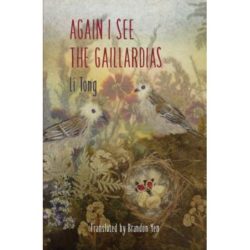Again I See the Gaillardias by Li Tong
Translated by Brandon Yen
Balestier Press, 2016
Publisher's Blurb
Through misunderstanding, sympathy, reconciliation and love, seven schoolchildren forged an abiding friendship in their hometown Penghu, a cluster of islands in the Taiwan Strait. Brought together by their Arts and Crafts teacher, the children learned to cherish their friendship and to understand their cultural roots. At their farewell party, they promised to come back for a reunion twenty years later, on the evening of the Mid-Autumn Festival.
Now working in Canada, Glasses is coming home to keep his promise. Penghu’s landscapes – waves, fields, cows, coral-stone walls, horsetail trees and gaillardias – summon back memories at school, in the pottery workshop, and on a trip to the Isle of Jibei. As he makes his way towards the old workshop, Glasses relives those memories and contemplates the meaning of home.
The Taiwanese writer Li Tong’s award-winning novel, Again I See the Gaillardias, is a deeply moving story about friendship, growing up, homecoming, self-identification and local attachments.
Winner of the 1986 Hong Chien-Chuan Children's Literature Award and the 1989 Yang Huan Literature Award
Reading Chinese Network Reviews
Reviewed by Joy Qiao, 21/11/17
 A novel of remarkable depth! That’s the impression Again I See the Gaillardias left on me after reading it at one sitting. Keeping the promise of twenty years ago, the seven friends came back to their motherland or, more specifically, their mother town, for reunion at the Mid-Autumn festival, a traditional Chinese festival for reunion of family members. The reunion, especially the gaillardias around their schoolyards took them back to the old days they spent together, to the memories hidden in the depth of their hearts, and the unforgettable friendship formed among them, the friendship between them and their “Brother-in-Law”(in fact their Arts and Crafts Teacher).
A novel of remarkable depth! That’s the impression Again I See the Gaillardias left on me after reading it at one sitting. Keeping the promise of twenty years ago, the seven friends came back to their motherland or, more specifically, their mother town, for reunion at the Mid-Autumn festival, a traditional Chinese festival for reunion of family members. The reunion, especially the gaillardias around their schoolyards took them back to the old days they spent together, to the memories hidden in the depth of their hearts, and the unforgettable friendship formed among them, the friendship between them and their “Brother-in-Law”(in fact their Arts and Crafts Teacher).
The novel breaks through the convention most children’s literary works may observe: kind of a fairy tale, kind of a magic story, or kind of a naughty-boy story…It is more about the real complicated process and feelings in developing friendship among juveniles. Just as what is said on the back cover of the novel’s English version, the “seven schoolchildren forged an abiding friendship,” “through misunderstanding, sympathy, reconciliation and love”. The special bond for their friendship the “Brother-in Law” aroused my great curiosity. As a teacher, I’m keen on learning about how this “Brother-in-Law” could get along with the students, how he gave the youngsters life guidance, how they finally developed the friendship despite the differences in age and identity. And also the novel implied a touching point – people’s self-identification with their culture and the root-seeking complex of an overseas Chinese. The gaillardias, as the symbol of their mother town, represent the spirit of the Taiwan People–their strong love for Taiwan though it was once belittled as a bare land. Although Glasses had been away for twenty years, the golden gaillardias have always been the permanent memory of, and attachment to, their hometown.
So after I read the Chinese version for the first time, I felt it would be really difficult to translate this novel into English if you would like to class it as children’s literature, from the surface level, with things like diction, sentence structure, text arrangement, to the deeper level issues such as style, transfer of the spirit of the source text, or even some cultural connotations. This encouraged me to read the English version to learn how the translator dealt with this challenge.
Opening the English version, I was intrigued by the presentation of the book as a whole. Similar to some biographies of famous persons like that of Steve Jobs, the English version of the novel supplies a Note on Names, which introduces the main characters – the seven friends, including their names and nicknames in both English and Pinyin, also the spelling rules and the characteristics of names in Taiwan. Among the nicknames, “Touch-Me-Not” is the one that only uses pure English but can accurately interpret the characteristic of Lin Wang-xi. That Note in fact is a good way to handle the cultural difference in translation, and also a good way to make the cultural barrier easier for the readers in other cultures to understand. But as for the “confusing” character Brother-in-Law, I wonder whether there is a good way to make it less confusing because Brother-in-Law is not a real brother-in-law, it only indicates his past relationship with the Sister - the homeroom teacher. Or maybe that’s the way the translator keeps loyal to the source text, and engages the readers.
Reviewed by Joy Qiao.
